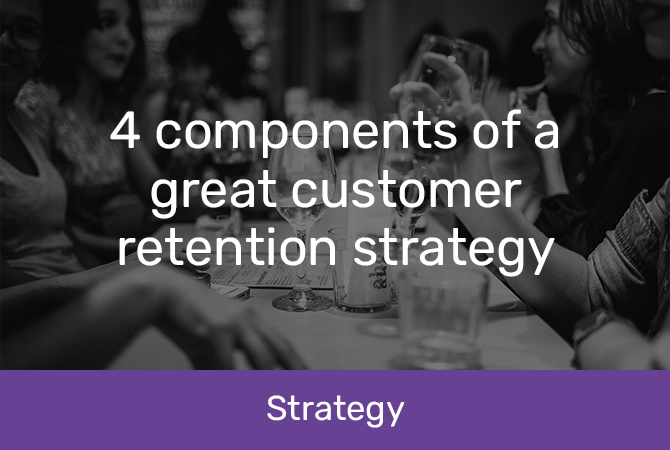
4 Components of a Great Customer Retention Strategy
BUILD A SOLID FOUNDATION FOR SECURING CUSTOMER LOYALTY
‘Customer insight’ is a big buzzword these days, and we’ll be the first to admit that we use it at Datamine - a lot. But in reality, having insight into who your customers are - their age, demographics, what they’re buying, where they’re buying, how they’re paying for it - isn’t actually the final goal. What businesses really want to be able to do is take that information and use it to improve their customer acquisition and retention outcomes.
So where to start? Firstly, determine what you need to know about your customers in order to retain them. Do you need to know what they’re buying so you can send them targeted marketing comms? Or know how much they’re spending so you can hone in on surprising and delighting your highest value customers? Or know where they’re buying so you can send them deals unique to their area?
If you can determine what information you need in order to better cater to and retain your customers, you can then start coming up with a great customer experience underpinned by the right data analytics to deliver it. Here are four common solutions we typically deploy for effective customer retention.
 1. Churn modelling
1. Churn modelling
If you aren’t sure which customers are at risk of leaving you, the best place to start could be cutting straight to the chase and implementing a churn model. Looking more deeply into the data surrounding your customer behaviour will help you:
- Understand the key differences between customers likely to churn and those who aren’t
- Understand the true business cost of churn and build a valid case for retention initiatives
- Target higher-risk customers with relevant messages at the right time
-
Identify where you can improve aspects of customer service that are known to contribute to customer churn
In a churn modelling project, we use your historical attrition data to train a predictive model to be able to detect when someone is showing signs of churning. The model uses Machine Learning to continuously learn from new data and become better and better at identifying potential churners in time to do something about it. For large companies with many customers, the dollar impact of improved customer retention can be measured in the millions - check out our Datamine Guide to Customer Retention for a more in-depth look at this solution.
 2. Customer segmentation
2. Customer segmentation
The idea behind segmentation is to divide up your massive customer base into smaller, more digestible groups of people who share similar attributes and can therefore be marketed to more personally, thus decreasing the likelihood of them churning. There are three primary types of segmentation – the first is good for tracking retention rates over time, and the other two are great for taking action:
- Strategic segmentations: Designed to look at large scale shifts in customer behaviour and identify macro opportunities. Strategic segmentations can be used to identify gaps in current product offerings or skews in customer base, to identify key differentiators that drive customer behaviour or to provide a common language for talking about customers
- Marketing segmentations: Designed to identify and capitalise on opportunities for revenue generation. This type of segmentation is used for targeting communications based on customer behaviour, identifying upsell, cross-sell and retention opportunities and providing a framework for allocating budget and monitoring campaign effectiveness
-
Operational segmentations: Designed for highly targeted activity – these are made up of potentially thousands of segments, each derived from a smaller set of behavioural variables specific to one activity. These micro segments are unstable, so this type of segmentation is about identifying certain ‘states’ and using certain customer attributes to deliver the most targeted action for that predefined state.
All of these can serve to help businesses better understand what is causing their customers to behave in certain ways (whether good or bad) and therefore know what steps to take in order to keep people around longer. The Datamine Guide to Customer Segmentation delves into these concepts more deeply, or you can check out a case study with BP NZ here.
 3. Loyalty programme assessment
3. Loyalty programme assessment
One of the best ways to keep customers coming back for more is by incentivising them to do so, which many organisations do through a loyalty programme - however, these schemes are often scrutinised (or even scrapped) when companies aren’t able to prove their true value. Loyalty programmes need to be monitored and tweaked on a regular basis to achieve a couple things:
- A clarified value proposition - what is this costing us, and what are we getting in return?
-
Updated programme benefits that capture high value spend at the lowest cost to the business
Datamine offers a number of solutions around loyalty programme development, improvement and assessment, all of which are designed to help you optimise your customer retention while keeping costs as low as possible. Check out this Postie+ case study outlining some work we did around optimising their programme rewards, or download the Datamine Guide to Loyalty Programmes.
 4. Customer profiling
4. Customer profiling
At its core, profiling is about providing a clear picture of various customer groups so you can better market to and retain them. This solution involves a deep-dive into behavioural and demographic data, as well as potentially census data, market research, business intelligence and more - all of which serve to give you a rounded view of the differences and similarities between your various customer segments.
Customer profiles enable companies to direct spending where it will have the greatest impact, rather than taking the ‘send and pray’ approach - armed with this deeper knowledge, you can deploy more targeted marketing and retention campaigns aimed at securing the loyalty of your high value customers. Have a read through the work Datamine did in this space with Cancer Society here if you're keen to learn more about what this looks like in practice.
 Where do you start?
Where do you start?
These are only a handful of the dozens of analytical solutions that can be used to improve customer retention. If you’re concerned about your customer attrition rates or want to proactively secure your customers’ loyalty, download one of the above Datamine Guides to learn more about that individual solution, or get in touch with us to begin the process yourself.














































